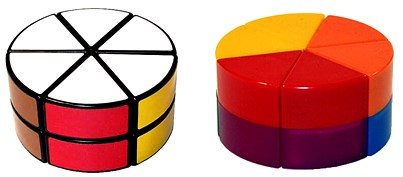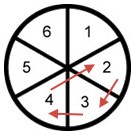Rubik’s Cheese
The Rubik’s Cheese is an interesting discussion point for many people in the twisty puzzle community, as two different versions of the Rubik’s Cheese puzzle exist. The first, the one which we will discuss here, is the two-layered version invented in 2002 by Anthony Greenhill and mass produced by Calvin’s Puzzle. This is the most commonly known Cheese puzzle (see image on the left). The second is the “original” single-layer Rubik’s Cheese, invented by Erno Rubik himself and patented in 1980. It was produced in very low quantities in Hungary, and it is very difficult to come across nowadays. If you happen to own one of the original 1980s Rubik’s Cheese puzzles, make sure you keep it in good condition, as it is potentially a very valuable item! Image 2 shows the original cheese puzzle in its solved state.

The mass-produced 2-layered and the extremely rare original Rubik's Cheese puzzles
Alien Cheese
Despite sharing very few physical characteristics, the Rubik’s Cheese was designed from a Rubik’s UFO mechanism. In fact, both of these puzzles share their very simple solution. If you’d like to see the tutorial for the Rubik’s UFO and see how it relates to this one.
Here we will go over the solution in simple terms, if there is anything you need more explanation for visit the link above. The colours around the circumference of the Rubik’s Cheese (on Figure 1, these are brown, red and yellow) are similar to the ridges on the Rubik’s UFO, except the ridges on the UFO are split between two sectors.
Overview
The steps to solving the Rubik’s Cheese are as follows:
- Solving the top and bottom faces in one step (solving one face solves the second).
- Match two adjacent outer colours.
- Keep matching sectors until solved or parity, in which case solve parity.
Notation
This method will use the same notation as the Rubik’s UFO tutorial, detailed below (this is also available on the UFO tutorial page in more detail and also diagrams that visually display these moves).
U – A single rotation of the top face in the clockwise direction.
U’ – A single rotation of the top face in the counter-clockwise direction (the opposite of a U move).
U2 – Two rotations of the top face in the clockwise direction.
U4’ – Four rotation of the top face in the counter-clockwise direction.
/ - A 180 degree vertical move of the three right-most sectors on the puzzle. This swaps the three sectors on the right half of the top face with the three sectors on the right side of the bottom face.
Solving the top and bottom faces in one step
The first part of solving the Rubik’s Cheese is intuitive. It is also simple than the Rubik’s UFO version of this step, as you do not need to match same-coloured sectors together dependent on their ridges, and you can simply get stuck in and match them up. If you find this stage difficult, try matching three adjacent sectors of one colour first, then flipping the puzzle so that they are in the bottom left-most positions of the puzzle. With this, you can perform / and U moves to match the remaining three sectors as follows:
- Match two adjacently to one another.
- Do a / move to bring them to the bottom layer with the three you already have solved.
- Move the final sector around on the top layer so that when you do another / move, it matches up with the first two.
- Place the three matched sectors next to the first three on the bottom layer.
Match two adjacent outer colours
 The next step may require the use of a single algorithm, which will be shown below. Here you need to perform a few U moves and check the outer colours as you go around the puzzle. Your goal is to match up an outer colour on the top row with the same colour on the bottom row (for reference, the two red outer colours in Figure 1 are matching). Next, check the two colours to the left and the two colours to the right of this pair. Hopefully at least one of them will also be solved. If not, try doing more U moves and checking the rest of the puzzle. If you can’t find two adjacent pairs, then you will need to do the following algorithm and check all the pairs again:
The next step may require the use of a single algorithm, which will be shown below. Here you need to perform a few U moves and check the outer colours as you go around the puzzle. Your goal is to match up an outer colour on the top row with the same colour on the bottom row (for reference, the two red outer colours in Figure 1 are matching). Next, check the two colours to the left and the two colours to the right of this pair. Hopefully at least one of them will also be solved. If not, try doing more U moves and checking the rest of the puzzle. If you can’t find two adjacent pairs, then you will need to do the following algorithm and check all the pairs again:
/ U’ / U2’ / U’ / U2’ / U’ / U2’ / U’ / U2
This algorithm is equivalent to the Rubik’s UFO algorithm and will cycle the sectors 2, 3 and 4 as follows:
- 2 –> 3
- 3 –> 4
- 4 –> 2
If you want to try and minimize the number of times you have to repeat this algorithm and the time it will take to do so, try and place your matched pair in position 5 by rotating the puzzle.
Once you have two matching adjacent pairs of colours, you can move on to the next step.
The remaining sectors
You can solve the remaining sectors in a similar way that you matched up the first two. First, you want to try and match a sector to the pair that you already built. This can be done by rotating the puzzle and putting the two pairs of colours in positions 5 and 6 on the diagram to preserve them then performing the above algorithm again.
Once you have three adjacent solved pairs, place them in positions 1, 6 and 5 on the diagram. Then simply perform the algorithm one or two more times until either all sectors are solved or all but two adjacent sectors are solved.
If you can’t solve the puzzle by performing the above algorithm twice, then you have parity. This is evident as only two sectors on one layer need to be swapped to complete the puzzle. This is much simpler to fix than on the Rubik’s UFO due to the physical restraints that the split ridges impose on it. If you have parity, simply place the two sectors than need to be flipped in positions 4 and 5 and repeat the same algorithm as in previous steps one more time, except this time instead of a U2 on the end, perform a single U. You should notice that you have three solved sectors again. Put these back in positions 1, 6 and 5 like you did earlier, and perform the algorithm one or two more times to solve the puzzle.
If there is anything in this tutorial that seemed confusing, please refer to the Rubik’s UFO tutorial as there are much more in-depth explanations of concepts that are assumed here available to you.